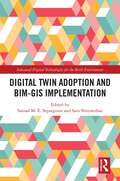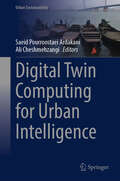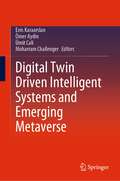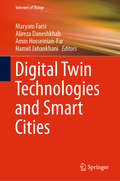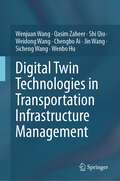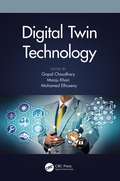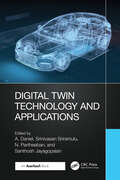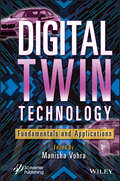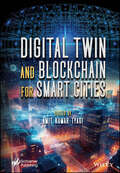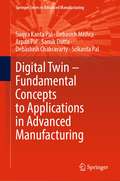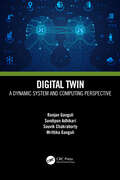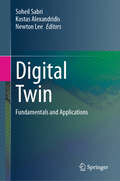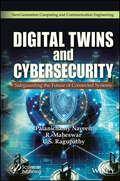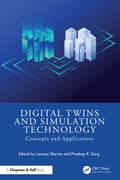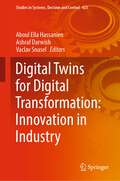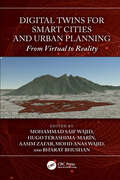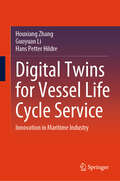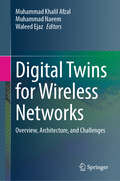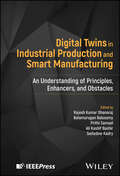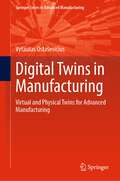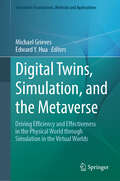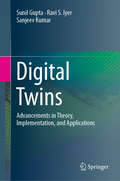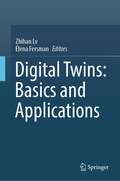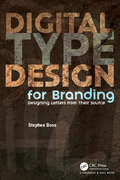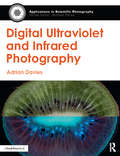- Table View
- List View
Digital Twin Adoption and BIM-GIS Implementation (Advanced Digital Technologies for the Built Environment)
by Sepasgozar, Samad M. E. Sara ShirowzhanThe aim of this edited book volume is to present new concepts, and applications of Digital Twin and relevant tools in the built environment context. The book identifies key organisational factors that influence the adoption of technology within the architectural service industry, setting the stage for a deeper understanding of the shift towards digital methodologies.The book introduces the Digital Twin Readiness Level framework, a modified metric system with ten levels of risk‑based maturity and an empirical development of a Digital Twin Adoption Model. Furthermore, the text ventures into immersive virtual environments and their applications, showcasing innovative practices that enhance learning and operational efficiency.Additionally, the book examines the integration of Building Information Modelling (BIM) and Geographic Information Systems (GIS), revealing new workflows for creating 3D models of cities. A focus on Australia’s government‑funded infrastructure projects offers insights into the values and acceptance criteria for these technologies, providing a comprehensive overview of their practical implications and future potential. This book is essential reading for practitioners, engineers, and managers involved in any phase of the built environment from design to operation and other architectural, engineering, and construction (AEC) stakeholders who are a part of digital transformations, as well as researchers, educators, and students interested in the field.
Digital Twin Computing for Urban Intelligence (Urban Sustainability)
by Ali Cheshmehzangi Saeid Pourroostaei ArdakaniDigital Twin Computing for Urban Intelligence focuses on new and ongoing discourses in interdisciplinary research and practice in urban system and smart city development pathways. It approaches digital twin fundamentals and principals including theoretical foundations, conceptualisations, strategies and services/patterns to define and adapt digital twin solutions for urban applications - mainly sustainability. This book highlights promising case studies and outlines digital twin design models and system architecture by examining key digital twin deployment practices such as data analysis, decision making, and service automation in the line with intelligent urban planning. It also emphasises on DT technologies such as cloud computing, AI, IoTs, and smart virtualisation and outlines the key benefits of the DT solutions in urban applications - mainly control and planning. This book is intended for a wide range of audiences, including interested layperson audiences, undergraduate and graduate students in university, and researchers. The key benefits of this book are: 1- To introduce the theoretical principles and fundamentals of DT computing for urban intelligence. 2- To present the state-of-the-art DT technologies in urban planning and control. 3- To describe the practical deployment process of DT computing solutions for urban sustainability and intelligence.
Digital Twin Driven Intelligent Systems and Emerging Metaverse
by Enis Karaarslan Ömer Aydin Ümit Cali Moharram ChallengerThis book covers the notion of the digital twin, which has the potential to alter the way systems are governed and manufactured. It also addresses the metaverse as an emerging technology with its roots in literature, cross-platform avatars, and artificial intelligence-oriented cybersecurity issues. The untapped potential of the metaverse and digital twins as enabling technologies for the next-generation industries is emphasized in various chapters. Digital twin technology enables manufacturers to comprehend their products throughout product design better, integrate simulation, tracking, and optimization in real-time, and appropriately analyze operations. Especially for complicated products or systems, testing on a digital twin is more efficient (more accessible, quicker, less error-prone, and less expensive). The product is examined in its virtual version before it is displayed in the actual world. Additionally, the digital twin minimizes operational expenses and increases the longevity of equipment and assets. By prolonging the life of the thing, they represent and enhance its working efficiency; it may minimize operating costs and prospective capital spending. The digital twin idea is becoming a reality as it has begun to be used in several industries, including energy, manufacturing, construction, transportation, aerospace, smart cities, healthcare, cyber security, finance, and agriculture. Academic and industrial experts highlighted the most compelling use cases of digital twins and metaverses and the challenges inherent in their implementation. Readers who want to make more effective systems will find the book useful. Also, people who want to get an idea and vision of how technology will change our lives will benefit from this book.
Digital Twin Technologies and Smart Cities (Internet of Things)
by Hamid Jahankhani Amin Hosseinian-Far Maryam Farsi Alireza DaneshkhahThis book provides a holistic perspective on Digital Twin (DT) technologies, and presents cutting-edge research in the field. It assesses the opportunities that DT can offer for smart cities, and covers the requirements for ensuring secure, safe and sustainable smart cities. Further, the book demonstrates that DT and its benefits with regard to: data visualisation, real-time data analytics, and learning leading to improved confidence in decision making;reasoning, monitoring and warning to support accurate diagnostics and prognostics;acting using edge control and what-if analysis; andconnection with back-end business applications hold significant potential for applications in smart cities, by employing a wide range of sensory and data-acquisition systems in various parts of the urban infrastructure. The contributing authors reveal how and why DT technologies that are used for monitoring, visualising, diagnosing and predicting in real-time are vital to cities’ sustainability and efficiency. The concepts outlined in the book represents a city together with all of its infrastructure elements, which communicate with each other in a complex manner. Moreover, securing Internet of Things (IoT) which is one of the key enablers of DT’s is discussed in details and from various perspectives. The book offers an outstanding reference guide for practitioners and researchers in manufacturing, operations research and communications, who are considering digitising some of their assets and related services. It is also a valuable asset for graduate students and academics who are looking to identify research gaps and develop their own proposals for further research.
Digital Twin Technologies in Transportation Infrastructure Management
by Jin Wang Weidong Wang Wenjuan Wang Qasim Zaheer Shi Qiu Chengbo Ai Sicheng Wang Wenbo HuThis book reveals the power of digital twin technologies in terms of optimizing the performance and maintenance of infrastructure assets. From roads, bridges, and tunnels to airports and smart cities, it will guide you through the latest advances in and use cases on this cutting-edge technology. You will come to understand the challenges involved in the development of digital twins and learn about the initiatives and projects underway to overcome them. Explore the potential of this technology in terms of reducing costs, improving system performance, and enhancing the overall infrastructure experience for users. Get ready to embark on a journey of understanding the future of transportation infrastructure management with digital twin technologies.
Digital Twin Technology
by Mohamed Elhoseny Manju Khari Gopal ChaudharyMost of the business sectors consider the Digital Twin concept as the next big thing in the industry. A current state analysis of their digital counterparts helps in the prediction of the future of physical assets. Organizations obtain better insights on their product performance through the implementation of Digital Twins, and the applications of the technology are frequently in sectors such as manufacturing, automobile, retail, health care, smart cities, industrial IoT, etc. This book explores the latest developments and covers the significant challenges, issues, and advances in Digital Twin Technology. It will be an essential resource for anybody involved in related industries, as well as anybody interested in learning more about this nascent technology. This book includes: The future, present, and past of Digital Twin Technology. Digital twin technologies across the Internet of Drones, which developed various perceptive and autonomous capabilities, towards different control strategies such as object detection, navigation, security, collision avoidance, and backup. These approaches help to deal with the expansive growth of big data solutions. The recent digital twin concept in agriculture, which offers the vertical framing by IoT installation development to enhance the problematic food supply situation. It also allows for significant energy savings practices. It is highly required to overcome those challenges in developing advanced imaging methods of disease detection & prediction to achieve more accuracy in large land areas of crops. The welfare of upcoming archetypes such as digitalization in forensic analysis. The ideas of digital twin have arisen to style the corporeal entity and associated facts reachable software and customers over digital platforms. Wind catchers as earth building: Digital Twins vs. green sustainable architecture.
Digital Twin Technology and Applications
by Srinivasan Sriramulu A Daniel N Partheeban Santhosh JayagopalanThe Fourth Industrial Revolution is being accelerated by the digital twin technological revolution, which converges intelligent technologies and defines the connectivity between physical and digital items. The Internet of Things (IoT) connects the real and digital worlds, allowing connected items to deliver a vast array of services to internet users. IoT devices create large amounts of data that may be fed into AI systems for decision- making. In a decentralized architecture, digital twin technology may be utilized to protect platforms and create smart contracts. Digital twins decentralized ledger, immutability, self- sovereign identification, and consensus procedures hold a lot of promise for improving AI algorithms. Furthermore, leveraging smart contracts in a digital twin system to facilitate user interaction via IoT might have a big influence, and this integrated platform is expected to revolutionize many fields.Digital Twin Technology and Applications examines the problems, issues, and solutions for using big data to enable streaming services using IoT and AI with digital twin technology. The IoT network concept is the key to success, and to establish a solid IoT platform on which large data transmission may take place, it must handle protocol, standards, and architecture. The book provides insight into the principles and techniques of IoT and AI. It explores the idea of using blockchain to provide security in a variety of sectors. The book also covers the application of integrated technologies to strengthen data models, improve insights and discoveries, innovate audit systems, as well as digital twin technology application to intelligent forecasting, smart finance, smart retail, global verification, and transparent governance.
Digital Twin Technology: Fundamentals and Applications
by Manisha VohraDIGITAL TWIN TECHNOLOGY The book lucidly explains the fundamentals of digital twin technology along with its applications and various industrial real-world examples. Digital twin basically means a replicated model of any object or product in digital form. A digital twin has many advantages as it remains connected with the original object or product it is replicating and receives real-time data. Therefore, the obstacles and issues that could be encountered in a product or object can be known before their actual happening which helps to prevent errors and major losses which otherwise might have been incurred. The various capabilities of digital twin technology make it a powerful tool that can be used to effectively boost various sectors of the healthcare, automotive, and construction industries, among others. Although this technology has been making its way into various sectors, it has not yet received the kind of exposure necessary to increase awareness of its potential in these industries. Therefore, it is critical that a better understanding of digital twin technology is acquired to facilitate growth and to have it implemented in the various sectors so that transformation can be ushered in. Therefore, this book was designed to be a useful resource for those who want to become well acquainted with digital twin technology. Audience Engineers, researchers, and advanced students in information technology, computer science, and electronics, as well as IT specialists and professionals in various industries such as healthcare, automotive, and transportation.
Digital Twin and Blockchain for Smart Cities
by Amit Kumar TyagiThe book uniquely explores the fundamentals of blockchain and digital twin technologies and their uses in smart cities. In the previous decade, many governments explored artificial intelligence, digital twin, and blockchain, and their roles in smart cities. This book discusses the convergence of two transformative technologies, digital twin and blockchain, to address urban challenges and propel the development of smarter, more sustainable cities. This convergence empowers cities to create real-time replicas of urban environments (digital twins) and secure, transparent data management (blockchain) to improve city planning, management, and civic services. In this application, the concept of a digital twin involves creating a virtual, data-driven replica of a city or specific urban systems, such as transportation, energy, or infrastructure. This digital twin mirrors the real world, gathering data from various sensors, IoT devices, and other sources to provide a holistic view of the city’s operations. Furthermore, blockchain technology offers a decentralized and tamper-resistant ledger for securely storing and managing data. In the context of smart cities, blockchain can ensure data integrity, privacy, and transparency, enabling trust and collaboration among various stakeholders. This book covers many important topics, including real-time city modeling; data security and the trustworthy storage of sensitive urban data; transparent governance to facilitate accountable governance and decision-making processes in smart cities; improved city services; disaster resilience (by providing insights into vulnerabilities and efficient resource allocation during crises); sustainable urban planning that optimizes resource allocation, reduces energy consumption, and minimizes environmental impact, which fosters sustainable development; citizen engagement; and much more. This book will not only provide information about more efficient, resilient, and sustainable urban environments, but it also empowers citizens to be active participants in shaping the future of their cities. By converging these technologies, cities can overcome existing challenges, encourage innovation, and create more livable, connected, and responsive urban spaces. Audience This book has a wide audience in computer science, artificial intelligence, and information technology as well as engineers in a variety of industrial manufacturing industries. It will also appeal to economists and government/city policymakers working on smart cities, the circular economy, clean tech investors, urban decision-makers, and environmental professionals.
Digital Twin – Fundamental Concepts to Applications in Advanced Manufacturing (Springer Series in Advanced Manufacturing)
by Surjya Kanta Pal Debasish Mishra Arpan Pal Samik Dutta Debashish Chakravarty Srikanta PalThis book provides readers with a guide to the use of Digital Twin in manufacturing. It presents a collection of fundamental ideas about sensor electronics and data acquisition, signal and image processing techniques, seamless data communications, artificial intelligence and machine learning for decision making, and explains their necessity for the practical application of Digital Twin in Industry.Providing case studies relevant to the manufacturing processes, systems, and sub-systems, this book is beneficial for both academics and industry professionals within the field of Industry 4.0 and digital manufacturing.
Digital Twin: A Dynamic System and Computing Perspective
by Ranjan Ganguli Sondipon Adhikari Souvik Chakraborty Mrittika GanguliThe digital twin of a physical system is an adaptive computer analog which exists in the cloud and adapts to changes in the physical system dynamically. This book introduces the computing, mathematical, and engineering background to understand and develop the concept of the digital twin. It provides background in modeling/simulation, computing technology, sensor/actuators, and so forth, needed to develop the next generation of digital twins. Concepts on cloud computing, big data, IoT, wireless communications, high-performance computing, and blockchain are also discussed. Features: Provides background material needed to understand digital twin technology Presents computational facet of digital twin Includes physics-based and surrogate model representations Addresses the problem of uncertainty in measurements and modeling Discusses practical case studies of implementation of digital twins, addressing additive manufacturing, server farms, predictive maintenance, and smart cities This book is aimed at graduate students and researchers in Electrical, Mechanical, Computer, and Production Engineering.
Digital Twin: Fundamentals and Applications
by Newton Lee Soheil Sabri Kostas AlexandridisDigital twin technologies, currently at the forefront of development, play a crucial role in integrated systems, industrial design, manufacturing, data analytics, and decision-making processes. As we move forward, digital twin technologies, along with their enabling technologies such as Artificial Intelligence, Machine Learning, Internet of Things (IoT), metaverse, and advanced visualization features, will continue to drive digital transformation and innovation across various societal contexts. This book presents a conceptual framework that examines critical perspectives on digital twins across diverse disciplines. It evaluates the contributions of leading thinkers to the broader discourse about digital twins. The introductory chapter provides an overview of the entire book, summarizing all subsequent chapters. Chapter 2 delves into the fundamentals of digital twins, covering theories, definitions, and enabling technologies. Chapters 3 to 10 explore various application areas, including smart cities, manufacturing, healthcare, infrastructure, and supply chain. Chapter 10 specifically focuses on socio-technical aspects related to the design, development, and implementation of digital twins. It emphasizes the significance of digital twins as a public good and identifies opportunities, gaps, and challenges. The final chapter addresses the current and future need for skills in training, education, and awareness, proposing collaborative approaches for industry and academia.
Digital Twins and Cybersecurity: Safeguarding the Future of Connected Systems
by R. Maheswar Palanichamy Naveen U. S. RagupathyThis book serves as a comprehensive guide to understanding the complex relationship between digital twins and cybersecurity, providing practical strategies for safeguarding connected systems. This book explores the convergence of digital twins and cybersecurity, offering insights, strategies, and best practices for safeguarding connected systems. It examines the definition, evolution, types, and applications of digital twins across industries like manufacturing, healthcare, and transportation. Highlighting growing digital threats, it underscores the need for robust cybersecurity measures to protect the integrity and confidentiality of digital twin ecosystems. The book analyzes key components and infrastructure of digital twins, including data flow, communication channels, vulnerabilities, and security considerations. It also addresses privacy challenges and explores relevant regulations and compliance requirements. Guiding readers through implementing security measures, it presents a comprehensive cybersecurity framework, covering data protection, encryption, and strategies for ensuring data integrity and confidentiality. It also explores incident response and recovery, secure communication protocols, and the roles of gateways and firewalls. Industry-specific challenges and mitigation strategies are examined through real-world case studies, offering valuable insights and lessons learned. Emerging trends in digital twin technology are thoroughly explored, including the impact of advancements such as AI and quantum computing and their associated cybersecurity challenges and solutions. Audience This book is an essential resource for professionals in the fields of cybersecurity and industrial and infrastructure sectors, including manufacturing, healthcare, transportation, and other industries that utilize digital twins. Researchers in computer science, cybersecurity, engineering, and technology, as well as policymakers and regulatory bodies, will also find this book highly useful.
Digital Twins and Simulation Technology: Concepts and Applications
by Lavanya Sharma and Pradeep K. GargThis book provides a comprehensive overview of the concept of digital twins, emphasising its strategic importance across various commercial domains. This book covers the fundamentals, data requirements, tools, and technologies essential for understanding and implementing digital twins. It discusses how digital twins are used for running simulations, analysing performance issues, and generating potential improvements to optimise business processes. The book explores the architecture, historical background, and real-time applications in sectors including urban planning, healthcare, smart cities, and manufacturing. Explains digital twin technology, including its core principles, architecture, and how it replicates physical objects in virtual platforms, in detail Covers the data types and tools necessary for creating and maintaining digital twins, including sensors, data processing systems, and integration methodologies Explores technologies such as Computer Vision, IoT, AI, ML, 5G, AR, and VR that drive the functionality and application of digital twins Analyses practical applications in diverse sectors like urban planning, smart cities, healthcare, manufacturing operations, and power-generation equipment, showcasing real-world use cases and benefits Examines real-time challenges and limitations associated with implementing digital twin technology, providing a balanced view of its capabilities and constraints It is a reference book for researchers, scholars, and students who are working or interested in learning about digital twin technology.
Digital Twins for Digital Transformation: Innovation in Industry (Studies in Systems, Decision and Control #423)
by Ashraf Darwish Vaclav Snasel Aboul Ella HassanienThis book aims to present dominant applications and use cases of the fast-evolving DT and determines vital Industry 4.0 technologies for building DT that can provide solutions for fighting local and globalmedical emergencies during pandemics. Moreover, it discusses a new framework integrating DT and blockchain technology to provide a more efficient and effective preventive conservation in different applications.
Digital Twins for Smart Cities and Urban Planning: From Virtual to Reality
by Bharat Bhushan Mohd Anas Wajid Aasim Zafar Mohammad Saif Wajid Hugo Terashima-MarínThis book discusses the concept of the digital twin, which has the potential to change how systems are managed and created. It also discusses the metaverse as a new technology with literary roots, cross-platform avatars, and artificial intelligence-related cybersecurity risks.Digital Twin for Smart Cities and Urban Planning: From Virtual to Reality provides practitioners with concrete problem-solving methodologies while covering the most recent and cutting-edge digital twin application technologies in diverse fields. It highlights the benefits of digital twins in terms of data visualization, real-time data analytics, and learning, which leads to increased confidence in decision-making. The book discusses the metaverse as a new technology with literary roots, cross-platform avatars, and artificial intelligence-related cybersecurity risks. It also evaluates the opportunities that DT can provide for smart cities and discusses the prerequisites for secure, safe, and sustainable smart cities. It also explores the mix between the industrial Internet of Things, artificial intelligence, machine learning, and software analytics with spatial network graphs to construct living digital simulation models that update and alter in response to changes in their physical counterparts. The chapters also focus on digital twin driven smart design which establishes a foundation for the adoption of digital twin technology in product design by drawing on the most recent industry practice and research.The book is an excellent resource for practitioners and scholars in manufacturing, operations research, and communications who are thinking about digitizing their assets and related services. It is also a helpful resource for graduate students and academics looking to better understand pioneering digital twins technologies.
Digital Twins for Vessel Life Cycle Service: Innovation in Maritime Industry
by Guoyuan Li Houxiang Zhang Hans Petter HildreThis book introduces the development of the digital twin of the marine infrastructure in Norway, which will be a significant scientific and operational achievement for the industry, making efficient and safe offshore operations possible. It enables data exchange safely and easily between different sub-systems, modules, and various applications. A complete digital twin ship will be presented in details. Thus, the twin ship can provide an integrated view of the ship’s various physical and behavioral aspects in different stages, and allow simultaneous optimization of functional performance requirements. In addition, it enables advanced control and optimization, e.g., creating more reliable prediction for flexible objectives (time, output, emissions, fuel consumption), and executing day-ahead and long-term planning for operations. More importantly, several related applications and case studies are presented in the end to confirm the effectiveness of the digital twin system. The research work is not only interesting for academia, also for industry.
Digital Twins for Wireless Networks: Overview, Architecture, and Challenges
by Waleed Ejaz Muhammad Khalil Afzal Muhammad NaeemThe sixth-generation (6G) communication systems are anticipated to provide network connectivity for an extensive range of use cases in a variety of emerging vertical industries. Consequently, a new set of challenging requirements and more stringent key performance indicators have to be considered, a novel architecture has to be designed, and unique enabling technologies shall be developed in order to fulfil the technical, regulatory, and business demands of the communication service customers. 6G networks are expected to offer even faster speeds, lower latency, and greater capacity compared to 5G networks, which will enable new applications and use cases that are currently not possible. Improved quality of life by enabling various applications (emerging Internet of everything applications) such as healthcare, brain-computer interactions, and extended reality is the main focus of future wireless services. Quality of experience, latency, and reliability are the key requirements of these applications. To meet these diverse requirements there is a need to assist wireless systems with unique technologies. Self-sustaining wireless systems (intelligence, seamless and ubiquitous connectivity) and proactive-online-learning-enables systems (Intelligent analytics) are two trends in future wireless systems. The digital twin technology is one of the most promising technologies that can be instrumental in realizing the technical and business objectives of 6G communication systems. A digital twin is a virtual imitation of a physical object or system. In a wireless system, a digital twin can be used to model and analyse the behaviour of the network and its components, such as antennas, transmitters, receivers, sensors, and other devices in wireless networks. One of the key benefits of using a digital twin for a wireless system is that it can help network operators and engineers to optimize the performance of the wireless network by simulating different scenarios and configurations. Other benefits include improve efficiency, cost saving, and enhanced security. In 6G networks, a digital twin could be used to simulate and optimize the performance. This could include simulating different network topologies, testing the performance of different network protocols and algorithms, and optimizing the placement of network infrastructure. To create a digital twin of a wireless network, a detailed model of the network and its components must be developed, based on real-world data and conditions. This model can then be used to simulate the behaviour of the network under different conditions and settings and to visualize the results in real time.
Digital Twins in Industrial Production and Smart Manufacturing: An Understanding of Principles, Enhancers, and Obstacles
by Seifedine Kadry Balamurugan Balusamy Ali Kashif Bashir Rajesh Kumar Dhanaraj Prithi SamuelComprehensive reference exploring the benefits and implementation of digital twins in industrial production and manufacturing Digital Twins in Industrial Production and Smart Manufacturing provides an overview of digital twin theoretical concepts, techniques, and recent trends used to meet the requirements and challenges of industrial production and smart manufacturing. The text describes how to achieve industrial excellence through virtual factory simulation and digital modeling innovations for next-generation manufacturing system design. The contributing authors address the many possible technical advantages of major Industry 5.0 technological advancements, using illustrations to aid readers in practical implementation of concepts, along with existing scenarios, potential research gaps, adoption difficulties, case studies, and future research objectives. The text also presents many applications and use cases of Industry 5.0 and digital twins in a variety of industries, including the aerospace industry, pharmaceutical manufacturing and biotech, augmented reality, virtual reality, edge computing and blockchain-based Internet of Things (IoT), cobots, intelligent logistics and supply chain management, and more. Edited by a group of highly qualified academics with significant experience in the field, Digital Twins in Industrial Production and Smart Manufacturing covers additional topics such as: Hyper-automation technology, including specialized workflow procedures and particular sectors of solicitations linked to hyper-automationDigital twins in the context of smart cities, with attempts to draw comparisons with the use of digital twins in industrial IoTVirtual factories based on digital twins and corresponding architecture to facilitate modeling, simulation, and assessment of manufacturing systemsCognitive, interactive, and standardization aspects of digital twins, and the proper implementation of digital twin technology for safety critical systems Digital Twins in Industrial Production and Smart Manufacturing is a must-have reference for researchers, scholars, and professionals in fields related to digital twins in industrial production and manufacturing. It is also suitable as a hands-on resource for students interested in the fields of digital twins and smart manufacturing.
Digital Twins in Manufacturing: Virtual and Physical Twins for Advanced Manufacturing (Springer Series in Advanced Manufacturing)
by Vytautas OstaševičiusThis book presents a guide to digital twin technologies and their applications within manufacturing. It examines key technological advances in the area of Industry 4.0, including numerical and experimental models and the Internet of Things (IoT), and explores their potential technical benefits through real-world application examples. This book presents digital models of advanced manufacturing processes dynamics that enable to control the cutting processes including experimental and simulation studies for brittle-ductile transition of ultra-precision machining materials assuring product quality. Innovative electrical power harvesting solutions from tool vibrations and wireless data transmission from confined and heavily cooled environment are also included. It explains the benefits of virtual and physical twins adapted to real systems, including the ability to shorten the product's path to the market, and enabling the transition to higher value-added manufacturing processes. Including numerous illustrations and clear solved problems, this book will be of interest to researchers and industry professionals in the fields of mechatronics, manufacturing engineering, computational mechanics.
Digital Twins, Simulation, and the Metaverse: Driving Efficiency and Effectiveness in the Physical World through Simulation in the Virtual Worlds (Simulation Foundations, Methods and Applications)
by Michael Grieves Edward Y. HuaDive into the fascinating world of Digital Twins, Simulation, and the Metaverse, where the virtual/digital and physical worlds collide and reshape industries. This book offers an insightful exploration of the revolutionary applications of these technologies, promising to ignite your imagination and inspire innovation. The topics described in this book represent a groundbreaking exploration of the synergistic relationship between digital twins, simulation, and the metaverse, as well as their transformative impact across various sectors. In addition to presenting theoretical discussions and experimental findings, this book focuses on real-life applications and illuminates the path for future research. This makes it a must-read for both industry and academia keen on understanding and harnessing the power of the emerging technologies. Topics and features: Discover from top thought leaders the predictions of how digital twins, simulation, and metaverses will evolve in direction, requirements, and capabilities Exploit the understanding of how digital-twin metaverses will revolutionize the effectiveness and efficiency of 21st-century work Explore cutting-edge, real-life applications of digital twins, simulation, and the metaverse (spanning a diverse array of industries and sectors) Understand the different views and perspectives of digital twins and metaverses shared by academia, industry, and government authors from around the world Learn how to harness the power of simulation in the world of digital twins and metaverses This unique volume consists of works from internationally renowned experts representing a diverse array of industries and sectors. It will be eminently suitable for researchers and practitioners working on modeling and simulation, digital twins, and the metaverse. Furthermore, this volume will serve as a valuable reference for executives and decision makers who are looking to leverage these cutting-edge technologies to expand their businesses, develop industrial and national strategies, and support future missions.
Digital Twins: Advancements in Theory, Implementation, and Applications
by Sunil Gupta Sanjeev Kumar Ravi S. IyerDigital twin technology has been rapidly evolving and gaining popularity in various fields such as manufacturing, energy, healthcare, and transportation. Digital twin is a virtual representation of a physical system or process that enables real-time monitoring, analysis, and optimization. This book will provide a comprehensive understanding of digital twin technology, its advancements, and applications. It will be useful for researchers, academics, practitioners, and students who are interested in the fields of engineering, computer science, data analytics, and Industry 4.0.
Digital Twins: Basics and Applications
by Zhihan Lv Elena FersmanThis book comprehensively introduces readers to Digital Twins, from the basic concepts, core technologies and technical architecture, to application scenarios and other aspects. Readers will gain a profound understanding of the emerging discipline of Digital Twins. Covering the latest and cutting-edge application technologies of Digital Twins in various fields, the book offers practitioners concrete problem-solving strategies. At the same time, it helps those working in Digital Twins-related fields to deepen their understanding of the industry and enhance their professional knowledge and skills. Given its scope, the book can also be used as teaching material or a reference book for teachers and students of product design, industrial design, design management, design marketing and related disciplines at colleges and universities. Covering a variety of groundbreaking Digital Twins technologies, it can also provide new directions for researchers.
Digital Type Design for Branding: Designing Letters from Their Source
by Stephen BossThe approach will be to give visual aid (illustrated) and written reference to young designers who are either launching their careers or taking their first stab at designing letterforms for a logo, lettermark, signage, advertising or an alphabet. The book will focus on the roots of each letterform and give the designers the knowledge of why weight variations (stress) exist and how to correctly apply them to their designs. <P><P>Key Features <li>A how-to resource for designers to referencee while designing letterforms. <li>The designer will be left with a clear understanding of why letterforms look the way they do, and the moethod and order of letterform development, enabling the designer to draw on history when developing their glyphs. <li>How-to illustrations will highlight the process and downloadable vectors will give the designer templates to begin their project. <li>This book gives designers a solid footing when designing a series of characters without developing a complete alphabet. <li>Custom typography is a growing trend and every newly minted designer should have a practical knowledge of the origins of letters and the method of building letterforms.
Digital Ultraviolet and Infrared Photography (Applications in Scientific Photography)
by Adrian DaviesDigital Ultraviolet and Infrared Photography discusses the growing number of applications of ultraviolet and infrared photography. Scientific and technical photographers, such as those engaged in scientific, medical, forensic, and landscape and wildlife photography routinely use ultraviolet and infrared techniques, and these techniques are growing in use in creative photography. This is the first book to address the application and potential for both ultraviolet and infrared photography in both science and art. The author, Adrian Davies, discusses the how-to of ultraviolet and infrared digital recording with a dissection of techniques, camera requirements and camera conversion, a useful appendix of resources and equipment currently available and inspirational image examples throughout. Digital Ultraviolet and Infrared Photography is an essential read for photographers using these tools either professionally or creatively.
